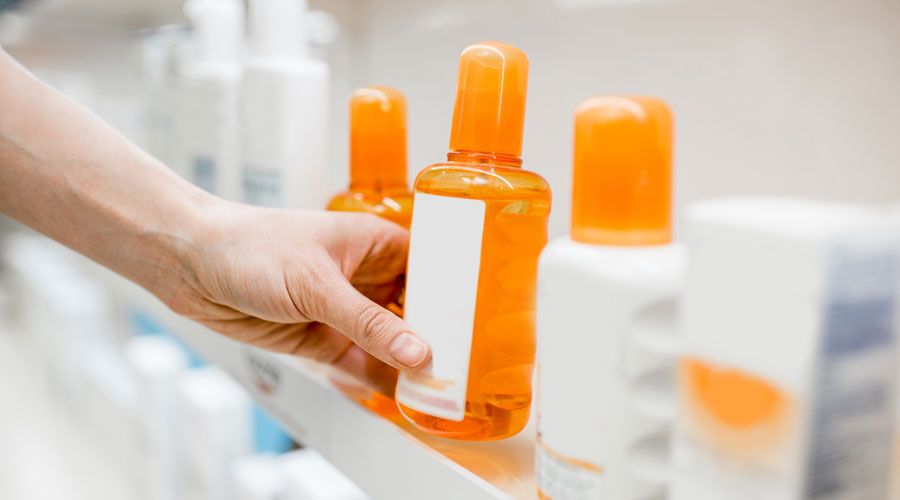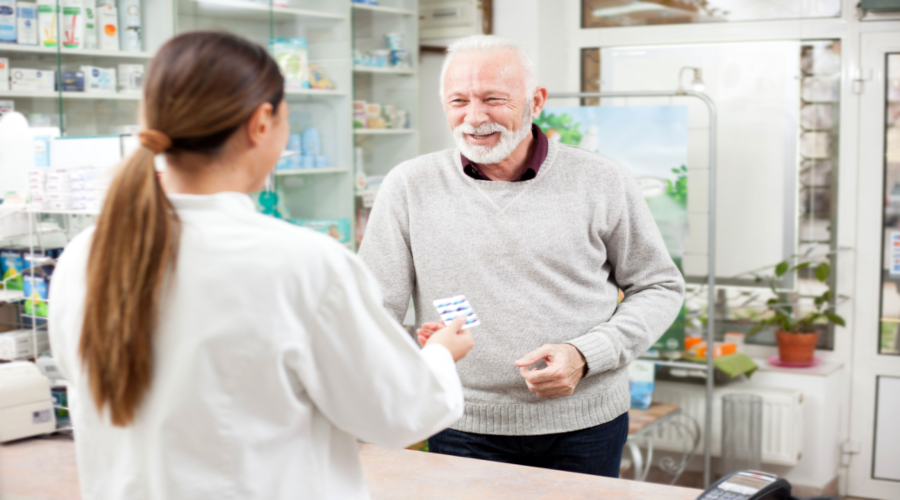Inside: Easily boost pharmacy revenue by promoting your front end to impulse shoppers. Use these strategies to help patients find what they need and increase sales.
Most independent community pharmacies stock retail items in the front end of their pharmacies.
Whether you choose to stock a front end to further support patients’ needs or because you think you’re supposed to have it, don’t let potential revenue just sit on the shelves.
Many pharmacy owners don’t think of their front ends as profit drivers.
They don’t invest enough time and effort into their front ends because they assume they can’t compete. They think shoppers won’t come in because they don’t have a wide selection of over-the-counter products (OTCs) like Walgreens or CVS. And, they assume they can’t beat the prices at dollar stores.
But with the right front-end strategies, independent pharmacies can increase front-end profit. And even though front-end profits look small in comparison to prescription profits, they play a part in your business’s total profits. And, you have the potential to get more out of them.
Front-end profit opportunities you’re missing out on:
- Drug-induced nutrient depletion (recommend OTCs to combat nutrient depletion from prescriptions)
- Vitamins and supplements (recommend vitamins and supplements to boost nutrient levels)
- Locally made products (stock products national chain pharmacies and dollar stores don’t)
- Supplementary products (help patients find the right supplementary products for them, like compression stockings, diabetes meters, and blood pressure monitors)
Thinking of patients as shoppers
Merchandising and marketing your front end requires knowledge of how people shop.
When it comes to your front end, you can boost your pharmacy’s profitability by also thinking of your patients as shoppers.
Consumers often make impulse buys and unplanned purchases when shopping. Understanding these types of shopping decisions can help encourage consumers to buy more retail products at your pharmacy.
What are impulse purchases?
Impulse purchases are purely based on desires. An impulse buy typically happens as an unplanned decision to buy a product right before making a purchase. For example, adding a candy bar to your purchase at the last minute.
What are unplanned purchases?
Shoppers’ needs determine whether or not they make unplanned purchases. For example, a display of personal care products might trigger shoppers to remember that they ran out of shampoo that morning and to make an unplanned purchase.
These types of purchases present a golden opportunity for you considering that 54 percent of consumers have spent more than $100 on an impulse purchase. And 20 percent have spent at least $1,000.
Know how people shop
Consumers have different shopping habits based on their personalities. And some personality types tend to impulse buy more than others. But nearly everyone makes impulse or unplanned purchases at some point. Here’s a look at how the majority of consumers shop.
Price-conscious consumers
About 20 percent of consumers are hyper price conscious. Price primarily drives their buying decisions. They’re more likely to shop around and the shopping experience is less important to them.
Not price-focused consumers
About 20 percent of consumers don’t care about price. They buy the product they need and don’t price shop.
Image shoppers
About 60 percent of consumers are image shoppers. These impulse shoppers buy what they like when they see it. For these shoppers, the benefits outweigh the costs related to the product.
7 Ways to Encourage Impulse Shoppers to Buy More
Don’t think of impulse shoppers as purely making purchases they don’t need.
With the right recommendations from pharmacists and knowledgeable staff, unplanned purchases can include much-needed items.
For example, recommending donning gloves to help a patient put on the compression stockings she’s purchasing. (She didn’t plan on making the purchase. But the product will help her.)
Your pharmacy’s potential for a sales-generating front end is already there. Enhance your front end with these tips to promote impulse and unplanned purchases.
1. Make shelves easy to navigate
Shoppers are more likely to purchase an item (or to make an impulse purchase) if they can easily see the merchandise.
Clearly display OTC medications and retail items so shoppers know what’s available.
Promote products you want to highlight with signage and point-of-purchase displays.
Why point-of-purchase displays encourage impulse buys:
- Displays help products get noticed; they stand out
- Consumers see that you have plenty of an item in stock
- Plenty of the same item makes it appear more popular (so they want to get in on it)
2. Place like-items together
Arrange certain items near one another to remind shoppers how they go together.
Organizing merchandise this way can encourage multiple purchases.
Ideas to arrange like-items together:
- Tissues near cough and cold products
- Sunscreen near aloe products
- Hand sanitizer and thermometers near cough and cold products
- Throat lozenges near allergy products
3. Recommend add-on purchases
Many shoppers respond well to suggestions.
One way to combine patient care and product recommendations is to suggest vitamins or supplements to combat drug-induced nutrient depletion.
If a patient is taking estrogens, point out your stock of magnesium, zinc or vitamin B6 supplements.
Or, if a patient is on an antibiotic such as tetracycline, doxycycline, Bactrim®, or Septra®, suggest he also purchase magnesium or calcium supplements to reduce potential side effects.
Related: Suggest These: 5 Add-On Products for Cold and Flu Season
4. Offer sales and discounts
Limited time promotional sales and discounts can encourage shoppers to purchase.
Consider offering discounts on items that you want to turn over quickly.
Another option is to mark down OTC medications as they reach their expiration dates.
5. Know who people impulse buy for
Impulse shoppers don’t necessarily make purchases for themselves.
In fact, men are three times more likely than women to impulse buy for their spouses. And, about 33 percent of women say they impulse buy mostly for their children.
Take these statistics into consideration when displaying your products.
Display ideas for men and women shoppers include:
- Create signage explaining why a spouse might benefit from a product (a new natural skin care line, multivitamins, locally made candles, etc.)
- Put children’s vitamins near the checkout counter for women to easily grab
6. Provide great customer service
Sometimes, clinching a sale hinges on the customer service you provide.
Make sure staff members are available to answer shoppers’ questions and to assist them in finding front-end items.
Also, display shelf signs to highlight certain products and to explain their benefits. Sometimes shoppers prefer to discover and learn about products on their own.
7. Simplify the checkout process
Once shoppers have decided on an impulse buy, don’t make them work to pay for it.
If shoppers have to wait in line, they’re more likely to experience buyer’s remorse and to put down one—or all of their purchases.
Keep adequate staff on hand to keep lines to a minimum.
Now’s the time to try these front-end strategies to encourage pharmacy impulse shoppers to make a purchase.
Want more pharmacy business tips and advice? Sign up for our e-newsletter.












